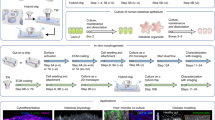Abstract
In this paper, we describe a microfabricated cell culture system (MCCS) for the microscopic live observation of cellular behavior in a reconstituted tissue-like microenvironment. The MCCS was used as a novel tool for tracking the proliferation of undifferentiated HT-29 cells. A wall structure of gelled extracellular matrix (ECM) protein was constructed inside the MCCS to establish a tissue-like microenvironment of the intestinal tissue. The ECM wall consisting of type I collagen retained the structural integrity during the gelation process and provided the adhesion surface for the HT-29 cells. We carried out the microscopic live observation of the proliferation of HT-29 cells seeded with various concentrations. The multilayered growth of HT-29 cells in the undifferentiated state was monitored without cell fixation, which was a necessary process in a conventional in vitro cell culture. The live tracking of cell culture also recorded the contraction of cell culture morphology during the initial period of cultivation. This approach is helpful for the establishment of an in vitro model for the live observation study of intestinal epithelial differentiation in an in vivo-like microenvironment.
Similar content being viewed by others
References
Young, E.W.K. & Beebe, D.J. Fundamentals of microfluidic cell culture in controlled microenvironments. Chem. Soc. Rev. 39, 1036–1048 (2010).
Wu, M.-H., Huang, S.-B. & Lee, G.-B., Microfluidic cell culture systems for drug research. Lab Chip 10, 939–956 (2010).
El-Ali, J., Sorger, P.K. & Jensen, K.F. Cells on chips. Nature 442, 403–411 (2006).
Song, J.W., Bazou, D. & Munn, L.L. Anastomosis of endothelial sprouts forms new vessels in a tissue analogue of angiogenesis. Integr. Biol. 4, 857–862 (2012).
Huh, D. et al. Reconstituting organ-level lung functions on a chip. Science 328, 1662–1668 (2010).
Imura, Y., Asano, Y., Sato, K. & Yoshimura, E. A microfluidic system to evaluate intestinal absorption. Anal. Sci. 25, 1403–1407 (2009).
Kim, H.J., Huh, D., Hamilton, G. & Ingber, D.E. Human gut-on-a-chip inhabited by microbial flora that experiences intestinal peristalsis-like motions and flow. Lab Chip 12, 2165–2174 (2012).
Kim, S.H. et al. Three-dimensional intestinal villi epithelium enhances protection of human intestinal cells from bacterial infection by inducing mucin expression. Integr. Biol. 6, 1122–1131 (2014).
Wu, W.-H. et al. A capillary-endothelium-mimetic microfluidic chip for the study of immune responses. Sensor. Actuat. B: Chem. 209, 470–477 (2015).
Zervantonakis, I.K. et al. Three-dimensional microfluidic model for tumor cell intravasation and endothelial barrier function. P. Natl. Acad. Sci. USA 109, 13515–13520 (2012).
Sudo, R. et al. Transport-mediated angiogenesis in 3D epithelial coculture. FASEB J. 23, 2155–2164 (2009).
Fogh, J. & Trempe, G. New human tumor cell lines. In Human tumor cells in vitro, 1 ed., Fogh, J., Ed. Springer US: Boston, MA, pp. 115–159 (1975).
Simon-Assmann, P., Turck, N., Sidhoum-Jenny, M., Gradwohl, G. & Kedinger, M. In vitro models of intestinal epithelial cell differentiation. Cell Biol. Toxicol. 23, 241–256 (2007).
Zweibaum, A., Laburthe, M., Grasset, E. & Louvard, D. Use of cultured cell lines in studies of intestinal cell differentiation and function. In Comprehensive physiology, John Wiley & Sons, Inc., pp. 223–225 (2011).
Lesuffleur, T., Barbat, A., Dussaulx, E. & Zweibaum, A. Growth adaptation to methotrexate of HT-29 human colon carcinoma cells is associated with their ability to differentiate into columnar absorptive and mucussecreting cells. Cancer Res. 50, 6334–6343 (1990).
Lesuffleur, T. et al. Dihydrofolate reductase gene amplification- associated shift of differentiation in methotrexate- adapted HT-29 cells. J. Cell Biol. 115, 1409–1418 (1991).
Rousset, M. The human colon carcinoma cell lines HT- 29 and Caco-2: Two in vitro models for the study of intestinal differentiation. Biochimie 68, 1035–1040 (1986).
East, J.A., Langdon, S.P., Townsend, K.M.S. & Hickman, J.A. The influence of type I collagen on the growth and differentiation of the human colonic adenocarcinoma cell line HT-29 in vitro. Differentiation 50, 179–188 (1992).
Lam, P., Wynne, K.J. & Wnek, G.E. Surface-tensionconfined microfluidics. Langmuir 18, 948–951 (2002).
Hwang, H., Park, J., Shin, C., Do, Y. & Cho, Y.-K. Three dimensional multicellular co-cultures and anticancer drug assays in rapid prototyped multilevel microfluidic devices. Biomed. Microdevices 15, 627–634 (2013).
Kleinman, H.K. & Martin, G.R. Matrigel: Basement membrane matrix with biological activity. Semin. Cancer Biol. 15, 378–386 (2005).
Hughes, C.S., Postovit, L.M. & Lajoie, G.A. Matrigel: A complex protein mixture required for optimal growth of cell culture. Proteomics 10, 1886–1890 (2010).
Simon-Assmann, P., Kedinger, M., De Arcangelis, A., Rousseau, V. & Simo, P. Extracellular matrix components in intestinal development. Experientia 51, 883–900 (1995).
Gervais, T., El-Ali, J., Gunther, A. & Jensen, K.F. Flowinduced deformation of shallow microfluidic channels. Lab Chip 6, 500–507 (2006).
Haier, J., Nasralla, M. & Nicolson, G.L. Different adhesion properties of highly and poorly metastatic HT-29 colon carcinoma cells with extracellular matrix components: Role of integrin expression and cytoskeletal components. Brit. J. Cancer 80, 1867–1874 (1999).
Yang, Y.-l., Motte, S. & Kaufman, L.J. Pore size variable type I collagen gels and their interaction with glioma cells. Biomaterials 31, 5678–5688 (2010).
Zaman, M.H. et al. Migration of tumor cells in 3D matrices is governed by matrix stiffness along with cell-matrix adhesion and proteolysis. P. tNatl. Acad. Sci. USA 103, 10889–10894 (2006).
Author information
Authors and Affiliations
Corresponding author
Rights and permissions
About this article
Cite this article
Lee, Y., Park, JK. Microfabricated cell culture system for the live cell observation of the multilayered proliferation of undifferentiated HT-29 cells. BioChip J 11, 308–315 (2017). https://doi.org/10.1007/s13206-017-1407-5
Received:
Revised:
Accepted:
Published:
Issue Date:
DOI: https://doi.org/10.1007/s13206-017-1407-5



